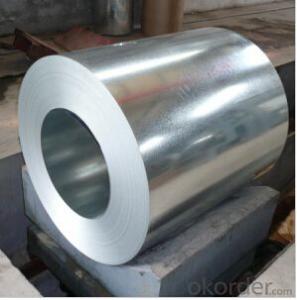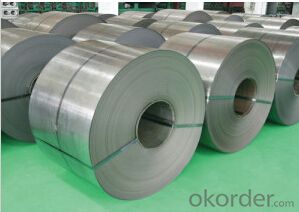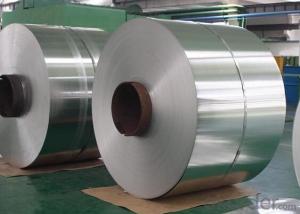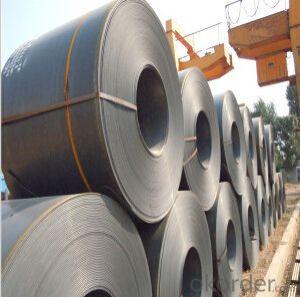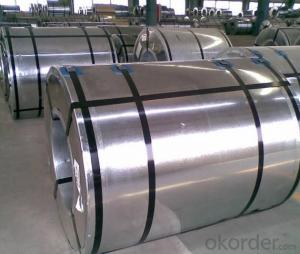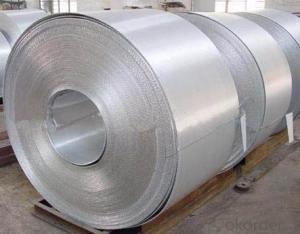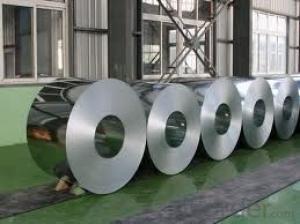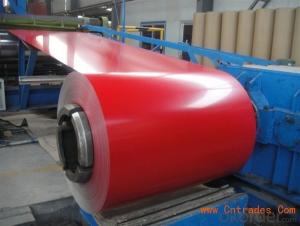Galvanized Steel Coil (S350GD+Z S250GD+ZF) Type: Structural Steel
- Loading Port:
- Tianjin
- Payment Terms:
- TT OR LC
- Min Order Qty:
- 25 m.t.
- Supply Capability:
- 10000 m.t./month
OKorder Service Pledge
OKorder Financial Service
You Might Also Like
Basic Info.
Model NO.:S350GD+Z S350GD+ZF
Surface Treatment:Galvanized
Technique:Cold Rolled
Standard:ASTM,JIS,GB,AISI,DIN,Bs and Others
Steel Grade:S350gd+Z S350gd+Zf
Export Markets:Global
Additional Info.
HS Code:72104900
Production Capacity:10000tons Per Month
Product Description
Brief Introduction:
Commodity name : Hot Dipped Galvanized Steel Coil
Standard we can provide: AISI ASTM BS DIN GB JIS
Grade : DC51D+Z,DC51D+ZF,St01Z,St02Z,St03Z
Zinc Coating:40g-275g/m2
Size we can provide:
Size Range: CRC substrate Thickness: 0.3-3.0mm
CRC substrate Width: 800-1830mm
HRC substrate Thickness:1.8-2.8mm
HRC substrate Width:900-1500mm
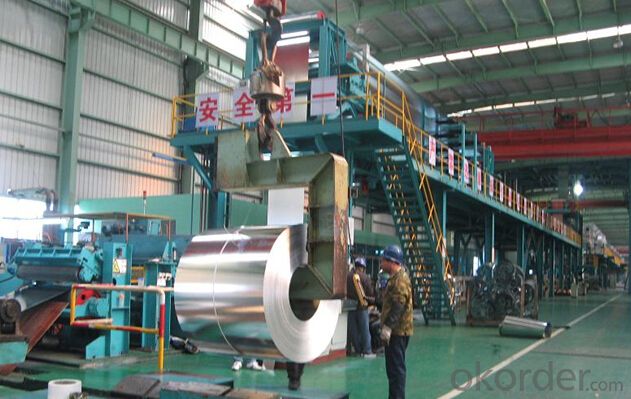
| Grade | Chemical composition % | |||||||||
| C | Si | Mn | P | S | Alta | Ti | Nb | |||
| No more than | No more than | No more than | No more than | No more than | No less than | No more than | No more than | |||
| DC51D+Z,DC51D+ZF | 0.1 | --- | 0.5 | 0.035 | 0.035 | --- | --- | --- | ||
| (St01Z,St02Z,St03Z) | ||||||||||
| Grade | Mechanical properties | plating adhesion | ||||||||
| yield strength | tensile strength | n 90 | r 90 | Elongation % | Plating weight(g/m 2 ) | |||||
| Mpa | Mpa | No less than | No less than | No less than | Bending diameter | |||||
| (a=thickness of slab) | ||||||||||
| L 0 =80mm b=20mm | ||||||||||
| Normal thickness mm | ||||||||||
| ≤ 0.7 | >0.7 | ≤ 140/140 | >140/140~ | >175/175 | ||||||
| 175/175 | ||||||||||
| DC51D+Z(St01Z,St02Z,St03 Z), DC51D+ZF | --- | 270~500 | --- | --- | 20 | 22 | 0a | 1a | 2a | |
| Exposure Test : | Salt Spray Test : | |||||||||
| Environment | GI | Enviroment | GI Average Corrosion | AL-ZN Average Corrosion | ||||||
| Average corrosion | ||||||||||
| g/m2 /y | μ m/y | g/m2/y | um/y | g/m2/y | um/y | |||||
| Tough Marine Climate | 140 | 9.8 | tough Marine Climate | 140 | 9.8 | 16 | 2.2 | |||
| Moderate Marine Climate | 18 | 1.3 | Modeerate Marine Climate | 18 | 1.3 | 4 | 0.54 | |||
| Industrial Climate | 20 | 1.4 | Industrial Climate | 20 | 1.4 | 4.2 | 0.57 | |||
| Countryside Climate | 4 | 0.28 | Countryside Climate | 4 | 0.28 | 1.3 | 0.17 | |||
| Plainness of hot dip galvanized substrate A.2.1 For steel sheet with a specified minimum yield strength less than 260MPa, the maximum plainness tolerance should be in conformity with the stipulations of Table A1. | ||||||||||
| MPa | Nominal width | Plainness (mm) for the nominal thickness as shown below | ||||||||
| Common precise PF.A | High-level precision PF.B | |||||||||
| <0.70 | 0.70~<1.60 | 1.60~3.0 | <0.70 | 0.70~<1.60 | 1.60~3.0 | |||||
| <260 | <1200 | 10 | 8 | 8 | 5 | 4 | 3 | |||
| 1200~<1500 | 12 | 10 | 10 | 6 | 5 | 4 | ||||
| ≥1500 | 17 | 15 | 15 | 8 | 7 | 6 | ||||
| For steel sheet and steel strip with a specified minimum yield strength not less than 260MPa but less than 360MPa,and the grades of DC51+Z/Z DD51D+Z /S550GD+Z/ZF), the maximum plainness tolerance should be in conformity with the stipulations of Table A2. Table A2 | ||||||||||
| MPa | Nominal width | Plainness (mm) for the nominal thickness as shown below | ||||||||
| Common precise PF.A | High-level precision PF.B | |||||||||
| <0.70 | 0.70~<1.60 | 1.60~3.0 | <0.70 | 0.70~<1.60 | 1.60~3.0 | |||||
| 260~<360 | <1200 | 13 | 10 | 10 | 8 | 6 | 5 | |||
| 1200~<1500 | 15 | 13 | 13 | 9 | 8 | 6 | ||||
| ≥1500 | 20 | 19 | 19 | 12 | 10 | 9 | ||||
| Thickness tolerance for hot dip galvanized substrate | ||||||||||
| For steel sheet with a specified minimum yield strength less than 260MPa, the maximum thickness tolerance should be in conformity with the stipulations of Table A6. | ||||||||||
| Nominal thickness | Thickness tolerance while the widths are showed as follows | |||||||||
| Common precise PT.A | High-level precision PT.B | |||||||||
| ≤1200 | >1200~1500 | >1500 | ≤1200 | >1200~1500 | >1500 | |||||
| 0.30~0.40 | ±0.04 | ±0.05 | ±0.06 | ±0.030 | ±0.035 | ±0.040 | ||||
| >0.40~0.60 | ±0.04 | ±0.05 | ±0.06 | ±0.035 | ±0.040 | ±0.045 | ||||
| >0.60~0.80 | ±0.05 | ±0.06 | ±0.07 | ±0.040 | ±0.045 | ±0.050 | ||||
| >0.80~1.00 | ±0.06 | ±0.07 | ±0.08 | ±0.045 | ±0.050 | ±0.060 | ||||
| >1.00~1.20 | ±0.07 | ±0.08 | ±0.09 | ±0.050 | ±0.060 | ±0.070 | ||||
| >1.20~1.60 | ±0.10 | ±0.11 | ±0.12 | ±0.060 | ±0.070 | ±0.080 | ||||
| >1.60~2.00 | ±0.12 | ±0.13 | ±0.14 | ±0.070 | ±0.080 | ±0.090 | ||||
| >2.00~2.50 | ±0.14 | ±0.15 | ±0.16 | ±0.090 | ±0.100 | ±0.110 | ||||
| >2.50~3.00 | ±0.17 | ±0.17 | ±0.18 | ±0.110 | ±0.120 | ±0.130 | ||||
| For steel sheet and steel strip with a specified minimum yield strength not less than 260MPa but less than 360MPa, the thickness tolerance should be in conformity with the stipulations of Table A7. | ||||||||||
| Nominal thickness | Thickness tolerance while the widths are showed as follows | |||||||||
| Common precise PT.A | High-level precision PT.B | |||||||||
| ≤1200 | >1200~1500 | >1500 | ≤1200 | >1200~1500 | >1500 | |||||
| 0.30~0.40 | ±0.05 | ±0.06 | ±0.07 | ±0.035 | ±0.040 | ±0.045 | ||||
| >0.40~0.60 | ±0.05 | ±0.06 | ±0.07 | ±0.040 | ±0.045 | ±0.050 | ||||
| >0.60~0.80 | ±0.06 | ±0.07 | ±0.08 | ±0.045 | ±0.050 | ±0.060 | ||||
| >0.80~1.00 | ±0.07 | ±0.08 | ±0.09 | ±0.050 | ±0.060 | ±0.070 | ||||
| >1.00~1.20 | ±0.08 | ±0.09 | ±0.11 | ±0.060 | ±0.070 | ±0.080 | ||||
| >1.20~1.60 | ±0.11 | ±0.13 | ±0.14 | ±0.070 | ±0.080 | ±0.090 | ||||
| >1.60~2.00 | ±0.14 | ±0.15 | ±0.16 | ±0.080 | ±0.090 | ±0.110 | ||||
| >2.00~2.50 | ±0.16 | ±0.17 | ±0.18 | ±0.110 | ±0.120 | ±0.130 | ||||
| >2.50~3.00 | ±0.19 | ±0.20 | ±0.20 | ±0.130 | ±0.140 | ±0.150 | ||||
| For steel sheet and steel strip with a specified minimum yield strength not less than 360MPa, but less than or equal to 420 MPa, the thickness tolerance should be in conformity with the stipulations of Table A8. | ||||||||||
| Nominal thickness | Thickness tolerance while the widths are showed as follows | |||||||||
| Common precise PT.A | High-level precision PT.B | |||||||||
| ≤1200 | >1200~1500 | >1500 | ≤1200 | >1200~1500 | >1500 | |||||
| 0.30~0.40 | ±0.05 | ±0.06 | ±0.07 | ±0.040 | ±0.045 | ±0.050 | ||||
| >0.40~0.60 | ±0.06 | ±0.07 | ±0.08 | ±0.045 | ±0.050 | ±0.060 | ||||
| >0.60~0.80 | ±0.07 | ±0.08 | ±0.09 | ±0.050 | ±0.060 | ±0.070 | ||||
| >0.80~1.00 | ±0.08 | ±0.09 | ±0.11 | ±0.060 | ±0.070 | ±0.080 | ||||
| >1.00~1.20 | ±0.10 | ±0.11 | ±0.12 | ±0.070 | ±0.080 | ±0.090 | ||||
| >1.20~1.60 | ±0.13 | ±0.14 | ±0.16 | ±0.080 | ±0.090 | ±0.110 | ||||
| >1.60~2.00 | ±0.16 | ±0.17 | ±0.19 | ±0.090 | ±0.110 | ±0.120 | ||||
| >2.00~2.50 | ±0.18 | ±0.20 | ±0.21 | ±0.120 | ±0.130 | ±0.140 | ||||
| >2.50~3.00 | ±0.22 | ±0.22 | ±0.23 | ±0.140 | ±0.150 | ±0.160 | ||||
| For steel sheet and steel strip with a specified minimum yield strength not less than 420MPa, but less than or equal to 900 MPa, the thickness tolerance should be in conformity with the stipulations of Table A9. | ||||||||||
| Nominal thickness | Thickness tolerance while the widths are showed as follows | |||||||||
| Common precise PT.A | High-level precision PT.B | |||||||||
| ≤1200 | >1200~1500 | >1500 | ≤1200 | >1200~1500 | >1500 | |||||
| 0.30~0.40 | ±0.06 | ±0.07 | ±0.08 | ±0.045 | ±0.050 | ±0.060 | ||||
| >0.40~0.60 | ±0.06 | ±0.08 | ±0.09 | ±0.050 | ±0.060 | ±0.070 | ||||
| >0.60~0.80 | ±0.07 | ±0.09 | ±0.11 | ±0.060 | ±0.070 | ±0.080 | ||||
| >0.80~1.00 | ±0.09 | ±0.11 | ±0.12 | ±0.070 | ±0.080 | ±0.090 | ||||
| >1.00~1.20 | ±0.11 | ±0.13 | ±0.14 | ±0.080 | ±0.090 | ±0.110 | ||||
| >1.20~1.60 | ±0.15 | ±0.16 | ±0.18 | ±0.090 | ±0.110 | ±0.120 | ||||
| >1.60~2.00 | ±0.18 | ±0.19 | ±0.21 | ±0.110 | ±0.120 | ±0.140 | ||||
| >2.00~2.50 | ±0.21 | ±0.22 | ±0.24 | ±0.140 | ±0.150 | ±0.170 | ||||
| >2.50~3.00 | ±0.24 | ±0.25 | ±0.26 | ±0.170 | ±0.180 | ±0.190 | ||||
| Width tolerance | ||||||||||
| Nominal width | Width tolerance | Width | ||||||||
FAQ
1.What's your MOQ?
25MT, it is for one container.
2.Do you have QC teams?
Yeah, sure, our QC team is very important, they will keep the quality control for our products.
3. What's your normal delivery time?
Our delivery time about 10-20days for standard sizes, if you have other requirements like hardness and width ,it is about 20-40days. But don't worry ,we also try our best for the delivery time ,because time longer and our cost is higher.
4.Are the products tested before shipping?
Yes, all of our PPGI and GI was qualified before shipping. We test every batch every day.
- Q: I want to know if it is possible to make regular steel stainless.From what I understand stainless consist of chromium about 10 percent I think.Any way I'm wondering if properties can be added in a process or can this only be possible during actual manufacturing of the steel.And I'm not talking about chrome like stainless steel that's not to shiny.
- This okorder /
- Q: What is the average tensile strength of a steel coil?
- The average tensile strength of a steel coil can vary depending on the specific type and grade of steel being used. However, on average, steel coils tend to have a tensile strength ranging from 300 to 2,000 megapascals (MPa).
- Q: How are steel coils coated for added protection?
- Steel coils are coated for added protection through a process called coil coating. During this process, the steel coils are cleaned and treated with a primer to promote adhesion. Then, a topcoat is applied, which can be a variety of materials such as paint, polymer, or zinc-based coatings. This coating provides a protective barrier against corrosion, abrasion, and other environmental factors, enhancing the durability and lifespan of the steel coils.
- Q: Can steel coils be coated with anti-microbial materials?
- Yes, steel coils can be coated with anti-microbial materials. These coatings are designed to inhibit the growth of microorganisms on the surface, providing added protection against bacterial or fungal contamination.
- Q: pros and cons of stainless steel and carbon steel swords
- For display stainless is ok, no maintenance is required, for actual use carbon steel it the way to go, these blades will rust and need to be taken care of.
- Q: What are the different surface treatments available for steel coils?
- There are several different surface treatments available for steel coils, including galvanizing, painting, and powder coating. Galvanizing involves applying a layer of zinc to the surface of the steel to provide corrosion resistance. Painting involves applying a layer of paint to the surface to enhance its appearance and protect it from rusting. Powder coating is a process where dry powder is electrostatically applied to the steel surface and then cured under heat to form a protective and decorative coating.
- Q: How much should someone sell a 6 ft stainless steel counter? How about one with a sink?
- Ask for the best offer on OKorder and find out.
- Q: what do they use to make stainless steel?and can stainless steel be melted again and again without losing it's Specifications
- This Site Might Help You. RE: What are the components of Stainless Steel? what do they use to make stainless steel? and can stainless steel be melted again and again without losing it's Specifications
- Q: Alright...Please tell me what I can and can't buy for Steel Legion in detail(Much Detail please)Ogryns.Las canons.The problem I'm having is that they don't have steel Legion Uniform..does it matter?1.I also heard that you can't use Commisar Yarrick.(So what could I use?)2.What are my Hq choices,Fast attack,Heavy Support,Elite etc.3.Steel Legion has a Commisar....(Do I buy one for each squad of Steel Legion or one?)Please in detail what should I buy...I don't have the codex yet but will soon!!4.I also heard that if I get Steel Legion I need a transport for everything?(Is this true?)5.Please be detail on what i can't and can buy!!(Please like HQ Squad leader,Sargent)
- here are a couple of things about the steel legion. you should have a lot of mechanized units, have chimaras for rvery squad if posible, artillery fire helps a hell of a lot. also sentinals and leman russes and hell hounds also help. if in apocolypse, use banblades and titans. storm trooper squads should be your base squadrons. put them in chimeras and get near the action, drop 'em off and rapid fire like CRAZY!!! the steel legion loves heavy weapons so remember to get some heavy weapons platforms. there favourite weapons are grenade and missle launchers. there is also an officer you can buy with a power sword with the steel legion look. steel legion are big xeno hunters. because commisar is a ork killer you should be allowed to field him. ratling/ sniper squads also help and if you can get a vindicare assassin that is very useful.
- Q: How are steel coils used in the production of telecommunications equipment?
- Steel coils are commonly used in the production of telecommunications equipment as they provide structural support and durability. These coils are used to create various components of telecommunications equipment, such as cabinets, racks, and enclosures. One important application of steel coils in telecommunications equipment is the manufacturing of cabinets. These cabinets house the sensitive electronic components and wiring used in telecommunications systems. Steel coils are typically formed and shaped to create the structure of these cabinets, providing a sturdy and reliable housing for the equipment. The steel material also provides protection against external factors like impacts, dust, and moisture, ensuring the longevity and integrity of the telecommunications equipment. Steel coils are also utilized in the production of racks for telecommunications equipment. These racks are designed to hold multiple pieces of equipment, such as servers, switches, and routers, in an organized and accessible manner. The strength and rigidity of steel coils make them an ideal material for constructing these racks, ensuring that they can bear the weight of multiple devices and withstand the constant handling and movement that occurs in telecommunication environments. Furthermore, steel coils are used to manufacture enclosures for telecommunications equipment. Enclosures are protective casings that shield sensitive electronic components from external influences like electromagnetic interference and physical damage. Steel coils are often formed into specific shapes and sizes to create these enclosures, providing a robust barrier that safeguards the equipment from various external threats. In summary, steel coils play a crucial role in the production of telecommunications equipment by providing structural support, durability, and protection. They are used to create cabinets, racks, and enclosures, which ensure the proper functioning and longevity of the sensitive electronic components used in telecommunication systems.
Send your message to us
Galvanized Steel Coil (S350GD+Z S250GD+ZF) Type: Structural Steel
- Loading Port:
- Tianjin
- Payment Terms:
- TT OR LC
- Min Order Qty:
- 25 m.t.
- Supply Capability:
- 10000 m.t./month
OKorder Service Pledge
OKorder Financial Service
Similar products
Hot products
Hot Searches
Related keywords
